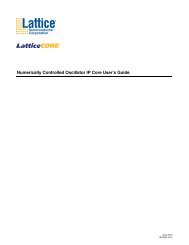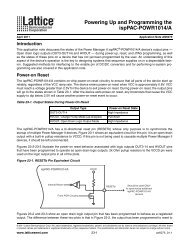DS1036 - Platform Manager Data Sheet - Lattice Semiconductor
DS1036 - Platform Manager Data Sheet - Lattice Semiconductor
DS1036 - Platform Manager Data Sheet - Lattice Semiconductor
You also want an ePaper? Increase the reach of your titles
YUMPU automatically turns print PDFs into web optimized ePapers that Google loves.
Overview<br />
69<br />
<strong>Platform</strong> <strong>Manager</strong> <strong>Data</strong> <strong>Sheet</strong><br />
An IEEE 1149.1 test access port (TAP) provides the control interface for serially accessing the digital I/O of the<br />
<strong>Platform</strong> <strong>Manager</strong>. The TAP controller is a state machine driven with mode and clock inputs. Given in the correct<br />
sequence, instructions are shifted into an instruction register, which then determines subsequent data input, data<br />
output, and related operations. Device programming is performed by addressing the configuration register, shifting<br />
data in, and then executing a program configuration instruction, after which the data is transferred to internal<br />
E 2 CMOS cells. It is these non-volatile cells that store the configuration or the <strong>Platform</strong> <strong>Manager</strong>. A set of instructions<br />
are defined that access all data registers and perform other internal control operations. For compatibility<br />
between compliant devices, two data registers are mandated by the IEEE 1149.1 specification. Others are functionally<br />
specified, but inclusion is strictly optional. Finally, there are provisions for optional data registers defined by<br />
the manufacturer. The two required registers are the bypass and boundary-scan registers. Figure 52 shows how<br />
the instruction and various data registers are organized in an <strong>Platform</strong> <strong>Manager</strong>.<br />
Figure 52. <strong>Platform</strong> <strong>Manager</strong> CPLD TAP Registers<br />
MULTIPLEXER<br />
TAP Controller Specifics<br />
DATA REGISTER (243 BITS)<br />
ADDRESS REGISTER (169 BITS)<br />
UES REGISTER (32 BITS)<br />
IDCODE REGISTER (32 BITS)<br />
CFG ADDRESS REGISTER (12 BITS)<br />
CFG DATA REGISTER (156 BITS)<br />
BYPASS REGISTER (1 BIT)<br />
INSTRUCTION REGISTER (8 BITS)<br />
TEST ACCESS PORT (TAP)<br />
LOGIC<br />
OUTPUT<br />
LATCH<br />
PTDI PTCK PTMS PTDO<br />
E 2CMOS<br />
NON-VOLATILE<br />
MEMORY<br />
The TAP is controlled by the Test Clock (PTCK) and Test Mode Select (PTMS) inputs. These inputs determine<br />
whether an Instruction Register or <strong>Data</strong> Register operation is performed. Driven by the PTCK input, the TAP consists<br />
of a small 16-state controller design. In a given state, the controller responds according to the level on the<br />
PTMS input as shown in Figure 53. Test <strong>Data</strong> In (PTDI) and PTMS are latched on the rising edge of PTCK, with<br />
Test <strong>Data</strong> Out (PTDO) becoming valid on the falling edge of PTCK. There are six steady states within the controller:<br />
Test-Logic-Reset, Run-Test/Idle, Shift-<strong>Data</strong>-Register, Pause-<strong>Data</strong>-Register, Shift-Instruction-Register and<br />
Pause-Instruction-Register. But there is only one steady state for the condition when PTMS is set high: the Test-<br />
Logic-Reset state. This allows a reset of the test logic within five PTCKs or less by keeping the PTMS input high.<br />
Test-Logic-Reset is the power-on default state.









